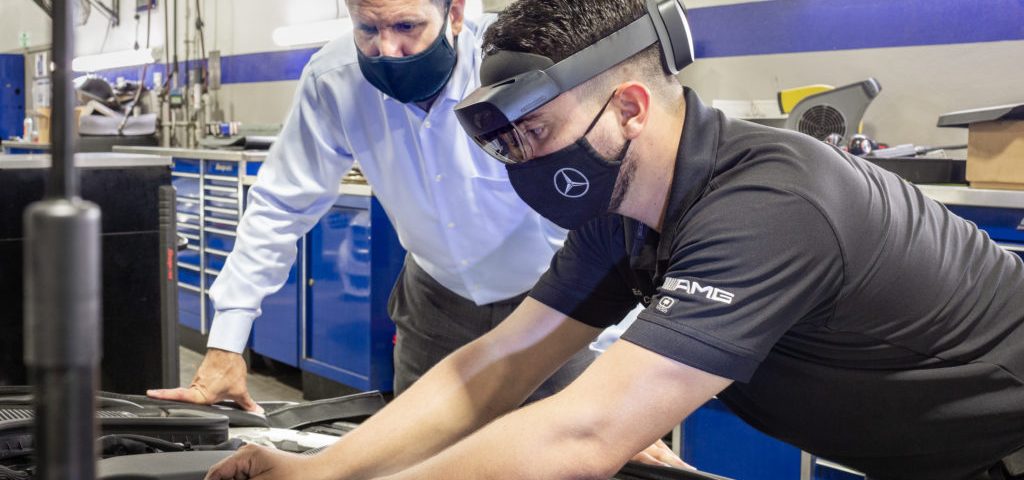
Home WiFi: The next Battle Ground for Service Providers: Part Three: Which is Better to Offer – Self-Serve or Self-Healing?
September 11, 2020
The road to recovery through technology: Empowering Malaysia’s ISVs
September 12, 2020Vroom with a view: HoloLens 2 powers faster fixes for Mercedes-Benz USA

Hours after resting his wrenches and, finally, his eyes, Mike Munoz has been known to relive challenging days in his sleep.
Such nights have typically followed long afternoons when a difficult maintenance issue temporarily stumped the Miami-based automotive technician. But somewhere between goodnight and first light, Munoz has often dreamed up solutions.
“There is a connection with a car that’s sitting back in your shop, in need of attention,” says Munoz, service manager at Mercedes-Benz of Coral Gables in South Florida. “You’re constantly thinking about it. Then, in my sleep, the answer would hit me. I’d wake up and say, ‘I have to try this!’”

Munoz has been a car guy since plunking down $900 for his first ride, an ’83 Chevy C10 that taught him oil changes and brake rebuilds.
Back then, it was all so simple under the hood. But as modern cars have become computerized machines packed with AI, augmented reality and other fancy tech, the work required to keep them on the road has become more complex – and technicians’ dreams aren’t yielding as many easy answers.
To help its service technicians more efficiently repair and maintain its models, Mercedes-Benz USA is outfitting all of its authorized American dealerships with HoloLens 2 headsets. The devices are equipped with Microsoft Dynamics 365 Remote Assist, a mixed reality app that that lets users collaborate during hands-free video calls from their own computers.
The tools enable diagnostic technicians at the dealerships to troubleshoot a problem in real time by tapping into Mercedes-Benz’ vast ecosystem of remote technical specialists with particular expertise across its various car lines. That network ranges from Mercedes-Benz field specialists in the U.S. who are schooled on the intricacies of each model to engineers at company headquarters in Germany who helped design those vehicles.
Now, a service technician like Edgar Campana, who works at Mercedes-Benz of Coral Gables, can wear a HoloLens 2 and share his view of the car part or car system in question while talking with one of the company’s remote technical specialists, via Dynamics 365 Remote Assist.

If he needs to peer deep inside the layers of machinery, Campana can gesture with his fingers at, say, the engine and immediately see a 3D hologram that appears next to the car.
Watching from a laptop or desktop computer, the remote specialist can ask Campana to turn his head toward a specific part or sensor, then share wiring diagrams, notes or other visual information directly into the view of the HoloLens 2.
What’s more, the remote specialist can draw on the hologram a picture of that engine (or other component) to show the technician where, for example, to adjust a specific cable. Multiple Mercedes-Benz specialists can join the same call.
“It’s like they are there. It’s like I am them,” Campana says. “The expert is looking through my eyes and seeing what I’m seeing so they can guide me.”

During his virtual conversations, Campana can keep his hands free to use his tools. He also can use the HoloLens 2 to drag the specialist-shared diagrams and documents behind him, away from his field of view. If he needs to view them again, he can just turn backward to reference them or drag them back in front.
“It makes everything easier,” Campana says. “We’re able to diagnose and address issues right there, get the car out of the garage and back to the customer much quicker.”
Mercedes-Benz USA has supplied HoloLens 2 devices to its authorized U.S. dealership partners, including Mercedes-Benz of Coral Gables.
Before the rollout, Campana and his fellow diagnostic technicians typically communicated via email with the remote technical specialists, who often are working to troubleshoot multiple queries across U.S. dealerships. Those back-and-forth email exchanges took time.
“We can now resolve issues often in minutes and hours as compared to days, allowing us to serve our customers more quickly with faster turnaround times,” Munoz says.
Inside Munoz’ service bays, his technicians work on about 100 cars a day.
Beyond the tech that enhances today’s cars, the vehicles rolling through Munoz’ shop offer another modern difference when compared to, say, the simple, combustion engine that powered his old Chevy C10.
Fixing vehicles these days demands strict attention to safety.
For instance, some hybrid cars have high-voltage components that require a manual power down of the battery to ensure technicians remain safe during the repair.

“A remote expert can guide us through that with HoloLens,” Munoz says. “Another example is that engines now have high-pressure, direct fuel injection. The fuel line is at almost 400 bars of pressure. If you crack open the wrong line, fuel will enter your skin, whether you like it or not.”
Six months into the COVID-19 pandemic – and the accompanying business shutdowns and re-openings – Mercedes-Benz service centers are currently “beyond busy” with customers completing scheduled maintenance and tending to any issues that crop up, says Andrew Sanders, an information systems project leader for Mercedes-Benz USA. He’s overseeing the company’s American rollout of HoloLens 2 devices.
“More than ever,” Sanders says, “the technicians need these tools – and the ability to receive that instant support.”
Top photo: A car is driven out of the service center and back to a customer at Mercedes-Benz of Coral Gables.
Photos by Remi Salva.
The post Vroom with a view: HoloLens 2 powers faster fixes for Mercedes-Benz USA appeared first on Microsoft Malaysia News Center.

